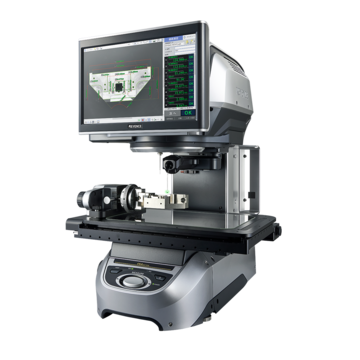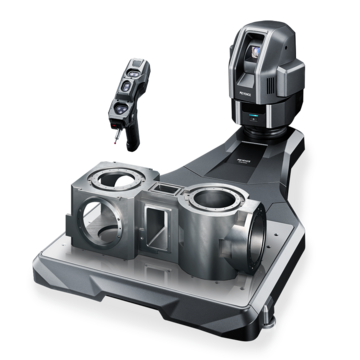Optical Comparator (Profile Projector)
Machining
Since the start of factories and manufacturing, the use of specialized equipment and various processes have helped shape the landscape of our world. One process that has played a key role in transforming raw materials into finished goods is machining.
In short, the process entails removing material to create parts used in all kinds of applications. It is a vital component of our everyday life, regardless of how advanced manufacturing technologies become.
Machining operations and processes are used throughout many industries worldwide, from automotive, aerospace, electronics, and more. The following will explore machining in manufacturing, types of machining, and the various machining tools.
What is Machining?
The broadened term is bound to beg the question; what is machining? Machining is a manufacturing process used to shape and size raw materials to fit desired products. It is referred to as a subtractive process, meaning it removes excess material to achieve a desired shape, dimension, and product. The machining process typically involves metal materials, but machinists will also work with wood, ceramic, and even plastics when suitable.
Machine tools are used to cut away bits of raw material known as chips from raw materials used for manufacturing processes, with this process often taking place very rapidly and efficiently. This type of operation requires an expert level of skill and tool selection for every task to be completed properly.
Machine tool work involves many forms of machining techniques, each with its advantages and use cases. These processes may be performed manually or using computerized numerical control (CNC) machining, which uses computer programming to manage the movement of the machine tool.
Machining is an essential element of manufacturing, allowing companies to produce high-quality parts that adhere to precise specifications. This highly complex process requires training, experience, and the right tools.
Different Types of Machining and When to Use Them
Machining in manufacturing can be divided into a few core types, namely turning, milling, and drilling, but there are other common processes too. Non-traditional methods include chemical, laser beam, abrasive jet, and water jet machining, to name a few.
Turning involves spinning the workpiece against a tool that either shaves or cuts away material to shape it. This is usually done using a lathe, but it may also involve other equipment like CNC machines and is suitable for round shapes.
Milling is another common form of machining. It involves feeding a rotating cutting tool into a workpiece to cut away chunks of material until achieving the desired shape. This technique is typically utilized when producing parts with intricate contours and precision is required.
Drilling is a technique for creating new holes or can be used to expand existing holes when required. This process involves drilling presses or lathes with compatible attachments, though handheld tools may also be utilized for this task.
Other machining techniques include planning, broaching, grinding, sawing, and filling. These are useful for various needs. For example, planning is often used to machine primarily large flat surfaces. Grinding is often implemented to improve a surface's finish and tolerances.
The Different Types of Machining Tools
Different types of machining tools are essential in various processes to shape, cut, and remove material from workpieces. Here are some examples of the machining tools being used in manufacturing:
- Lathes: Lathes are versatile machining tools used for turning operations. They rotate the workpiece while a cutting tool is applied to shape and remove material. Lathes are used to create cylindrical shapes, such as shafts, rods, and tubes.
- Milling Machines: Milling machines employ rotating cutting tools to remove material from the workpiece. These tools move along multiple axes, allowing for the creation of complex shapes and features. Milling machines are widely used for cutting, drilling, and slotting operations.
- Drills: Drills are machining tools designed explicitly for creating holes in workpieces. They use a rotating drill bit to penetrate the material. Drilling machines come in various sizes and configurations to accommodate different hole sizes and depths.
- Grinders: Grinders utilize an abrasive wheel to remove material from the surface of a workpiece. They are used for precision grinding, achieving tight tolerances, and providing excellent surface finishes. Grinders are commonly used in tool and die manufacturing and in the production of molds and precision components.
- Broaching Machines: Broaching machines are specialized tools for creating internal or external shapes in a workpiece. They employ a tool with multiple cutting teeth that gradually remove material in a single pass. Broaching is commonly used for producing keyways, splines, and other intricate profiles.
- Saws: Saws are used for cutting workpieces into desired lengths or shapes. Different types of saws (i.e., band, circular, and abrasive) are used for different materials and precise cutting applications.
- Boring Machines: Boring machines are used to enlarge or refine existing holes in workpieces. They employ cutting tools that remove material from the inside of the workpiece. Boring machines are commonly used in machining operations that require high accuracy and precise hole dimensions.
- Honing Machines: Honing machines improve the surface finish and accuracy of bores and cylinders. They utilize abrasives and specialized tools to create a smooth and precise finish.
As you see, machining requires specialized tools to perform various processes. Each industry and manufacturer utilizes these and similar tools to meet their specific needs.
Best Practices for Machining
Regardless of the scope of the project, there are many well-known best practices for machining. These points consider efficiency and safety more than anything else, and rightfully so.
Common best practices operators and manufacturers should follow include:
- Proper material and tool selection
- Optimized cutting patterns for consistency
- Toolpath optimization
- Applying coolant and lubrication if needed
- Utilizing thorough quality control methods
While machining centers can be extremely effective, they aren’t perfect 100% of the time. It’s vital to take a quality control outlook across all types of machining. Engaging in best practices considers efficiency and safety, both of which are essentials in manufacturing.
It is also common to find that varying best practices are utilized differently depending on the job. Manufacturing can require an adaptive, think-on-your-feet approach. This makes it important to be well aware of numerous best practices so it’s easier to adjust on the manufacturing floor.
As time goes on, new best practices are bound to arise as newer technologies find their way into the industry. The manufacturing process will always carry best practices that can’t be beaten, but new technology integrations should be an expectation at this point.
Advancements in Machining Equipment
Machining equipment isn’t new to the manufacturing industry by any means, but there’s always room for improvement. With modern advancements in technology, machining has taken an impressive turn for the better as time goes on.
Developments in CNC, additive manufacturing integrations, and high-speed machining are a few notable areas of improvement. Considering the needs behind modern manufacturing, we can expect future developments in the process to come to light.
This will be seen in multitasking capabilities, automation, in-process monitoring and control, and much more. The same goes for the quality control processes that follow. Such advancements as handheld CMMs can make the entire operation much more efficient.
Evolution of Machining Methods
Over the years, machining processes have been fine-tuned to optimize results in more ways than one. While several nuanced processes are involved with different machine types, the methods themselves are universal.
These pertain to subtractive and additive methods. The subtractive method creates a desired shape by removing unwanted material from a bigger piece of metal material. When it comes to additives, this includes the construction of a 3D object using a digital model. It’s important to highlight that additive methods are considered to be relatively new in comparison.
Common Challenges Faced in Machining Methods
Even with the help of modern technologies and professionals with years of experience, the process still has quite a few challenges. These are bound to vary for various reasons, but they must be addressed nonetheless.
A few common challenges associated with machining methods include:
- Wear and tear on tools
- Maintaining dimensional accuracy
- Choosing the right materials
- Cost management
The machine manufacturing process has been refined throughout the years and will continue to do so moving forward. It should be noted that some of these challenges can be mitigated with the help of measurement technology found in the various types of CMM machines.
Final Thoughts
Machining in manufacturing is an indispensable process that allows producers to transform raw materials into precise and functional components. With the wide range of machining types and processes outlined above, manufacturers have the flexibility to produce complex shapes and deliver high-quality products. From turning and milling to drilling and grinding, each machining process offers unique advantages and is suitable for specific applications.
As technology continues to advance, the future of machining holds exciting possibilities, ensuring the manufacturing industry remains at the forefront of innovation and precision. While the manufacturing process won’t become obsolete, we’re likely to see many challenges alleviated with the help of new manufacturing technology integrations.
KEYENCE offers products that help check that you're machining correctly. To see how our products can assist your machining process, check out our IM Series Instant Measurement System for quality checks on parts under 1ft, and for anything larger, look up our XM Series Handheld CMM. If you have any questions about our products, be sure to call our team at 1-888-539-3623 today.
Related Downloads

Brochure for the XM-5000 Series Handheld CMM. Portable CMM to easily and accurately measure 3D and GD&T features anywhere including the shop floor and in the machine tool.

Brochure for the IM-8000 Series Image Dimension Measurement System. Accurately measure parts in seconds at the push of a button.


![YOUR GUIDE TO ADVANCED MEASUREMENT TECHNIQUES [New Common Measurement Practices]](/img/asset/AS_116631_L.jpg)

